The Icelandic Horse: your guide
Find out what makes Icelandic Horses unique, why they can’t return to Iceland and how to ride these beautiful creatures yourself with our guide.
28. september 2022
The Icelandic Horse: your guide
Find out what makes Icelandic Horses unique, why they can’t return to Iceland and how to ride these beautiful creatures yourself with our guide.
28. september 2022
Known to horse breeders and equine enthusiasts across the world for its hardy nature, friendly demeanour and unique traits, the Icelandic horse stands out from all other breeds. A history of pure breeding, being forbidden to return once it leaves Iceland’s shores and resistance to any other horse breeds on the island means the Icelandic horse is unlike any other. The horse is loved and revered across Iceland, woven into the culture, mythology and literature, and you can get to know this intriguing equine breed yourself with our selection of horse riding tours and activities in Iceland.
The history of the Icelandic Horse
The first Norse settlers brought horses to Iceland, as far back as the 9th century when written records tell of the era of settlement. The Icelandic horse has survived the dramatic changing of the restless land over the centuries, from volcanic eruptions to bitter cold, harsh winters and mini ice ages.
Around 900 years ago, attempts to introduce eastern stock into the bloodline, saw significant degeneration, almost wipinging out the species. So the Icelandic horse has remained purebred, with no external genetics permitted to enter the bloodline.
Throughout history, horses have been essential to the survival of the Icelandic people. Horses were a reliable form of transportation across the island, able to carry heavy loads, and they even saved lives. Riders lost in the harsh blizzards of Icelandic winter would be kept warm by their horses, or their steed would trot on home with the exhausted or injured rider on their back.
The road network across Iceland in modern times has certainly reduced the need for a horse. But the Icelandic horse still holds a place in the country’s heart – still used for herding sheep in the mountains, leisurely rides on the beach and in racing and competitions.
Characteristics of the Icelandic Horse
Throughout the centuries, only the best horses were chosen for breeding in Iceland. Breeding horses were chosen based on specific characteristics, such as colour and equine conformation. Icelandic horses can often be seen sporting a fabulous, thick mane and come in around forty different colours and various patterns.
Those that come face-to-face with an Icelandic horse might see its stocky build and shorter-than-average legs and assume it would be classed as a pony. They usually stand between 13 and 14 hands high.
Adapting to its habitat over the centuries, the Icelandic horse grows a thick coat in winter and sheds to a lighter coat in summer. Due to the care and attention given by owners to their Icelandic horses, the average lifespan is up to 40 years. The oldest reported Icelandic horse lived until 59 years old.
Icelandic Horses in Mythology and folklore
 "Odin Rides to Hel" (1908) by W. G. Collingwood.
"Odin Rides to Hel" (1908) by W. G. Collingwood.
Horses were so intrinsic to Icelandic society that they appear in the country’s first book of laws. In it, the theft of horses was declared as punishable by banishment from the community, making horse thieves outlaws. Back in the Viking Age, if you were an outlaw, you could legally be killed on sight.
During the Viking Age, when the dead were buried with their personal belongings, kings and chieftains would often be buried with their trusty steed. Horses were considered valuable and there was a belief that they could assist your way to the land beyond.
One of the most famous horses in Norse mythology is Odin’s eight-legged steed, Sleipnir. In Iceland, the Northern canyon of Ásbyrgi is said to have been made by the imprint of Sleipnir’s hoof as he planted a foot there mid-flight.
Not all mythical horses were as friendly as their real counterparts. One of the monsters of Icelandic folklore, the Nykur, was a horse-like water demon whose ears and hooves faced backwards. The Nykur would hang out near lakes and rivers, pretending to be a normal horse and lure unsuspecting victims to a cold, watery grave. The cracking and groaning of ice on water is said to be the neighing of the Nykur. You can hear this sound yourself at Jökulsárlón glacier lagoon, but from the safety of a boat.
Interesting facts about the Icelandic Horse

Casting your eyes across the rugged Icelandic mountains, you may assume you’re spotting wild horses grazing in the greenery and running free across the landscape. However, the vast majority of horses in Iceland belong to farms or stables. There is just a tiny herd of actual wild Icelandic horses, estimated to be around 100 in the whole country.
In Iceland, each horse is treated as important as a human, in terms of registration that is. Horses are given their own ‘kennitala’ (like a social security or national insurance number). Most owners keep track of their horses via an app on their phones.
Icelandic horses come in over 100 different colours and patterns. The rarest of these is considered to be litföróttur – roughly translating as ‘colour travellers’. In these horses, the coat colour changes several times a season, creating a sort-of in-between colour look.
You can sometimes spot Icelandic horses with piercing blue eyes, the colour of ice shards. Sometimes a white colouring over the eyes can cause this effect.
• For more interesting facts about Iceland in general, check out our blog post on the best fun facts about the island.
The Five Gaits of the Icelandic Horse and the unique Tölt
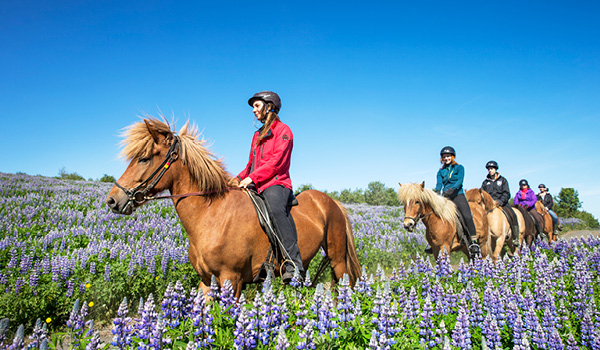
Like all horses, the Icelandic horse can perform the three traditional gaits – a walk, trot and gallop. But there are two unique traits to the Icelandic horse that set it apart from the rest of the equine world. The tölt is a fluid, smooth movement without the bumpy bounce you usually experience during horse riding. During the tölt, at least one of the horse’s hooves is on the ground at any one time.
The skeið is fast – it can be up to 48km/h (or 30mph). Both legs on one side of the horse touch the ground at the same time, making this gait look a little like a human running. It’s often called ‘flying speed’ as there are points during this gait where the horse’s hooves don’t touch the ground at all.
It is said to be the Icelandic horse’s unique genetic mutations that allow it to perform these two unique gaits.
Frequently asked questions about the Icelandic Horse
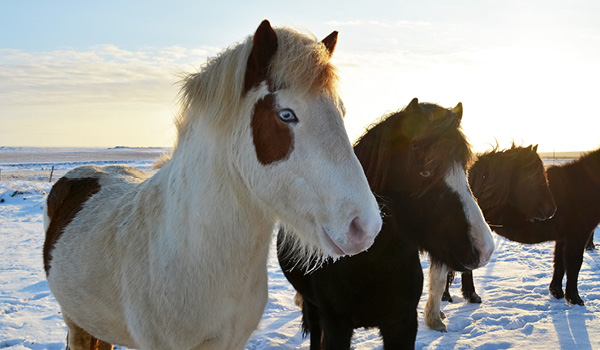
o How many horses are there in Iceland?
It’s easy to keep track of how many horses there are in Iceland as each one is registered with a unique number. Currently, it is estimated that there are around 80,000 horses in Iceland. That’s a lot for a country of just 350,000 people. Overall, there are around 180,000 Icelandic horses across the world, and of the 100,000 that live outside of Iceland, the biggest number is in Germany where this sturdy little breed is very popular.
o Why can't Icelandic horses return?
Yes, it’s true; once they leave the country, Icelandic horses are not allowed to return. The ancient Althing parliament passed laws in 982 AD preventing the importation of any other horse breeds to the island. So, for over a thousand years, the Icelandic breed has been kept in complete isolation. Iceland is also completely free from hoof and mouth diseases, so cannot risk re-importing a horse once it has left Icelandic soil.
o Are Icelandic horses friendly?
Icelandic horses are one of the friendliest breeds in the world. Apart from being small but mighty, and their two unique gaits, what makes the Iceland horse so special is its friendly temperament. With vast, open greenery to run around in as foals, the Icelandic horses have happy childhoods filled with freedom and little contact with anything other than other horses. So, because they have never encountered any natural predators, they are approachable and friendly as they are not easily spooked.
o Why is an Icelandic horse not a pony?
Although there’s no official definition of a pony, generally an equine standing less than 14.2 hands is considered a pony, rather than a horse. The Icelandic horses stand between 13 and 14 hands, so they should be classed as ponies by all logic. However, it is said that the Icelandic breed’s ability to carry heavy weights, their spirited temperament and their general hardiness means that they are considered horses by Icelanders and non-Icelanders alike. After all, they can do everything a horse does and have the demeanour of a horse.
The most likely reason they are considered horses is simply; tradition. Icelanders have always called them horses, and so it has come to be. You can’t argue with that!
Best time to see horses in Iceland
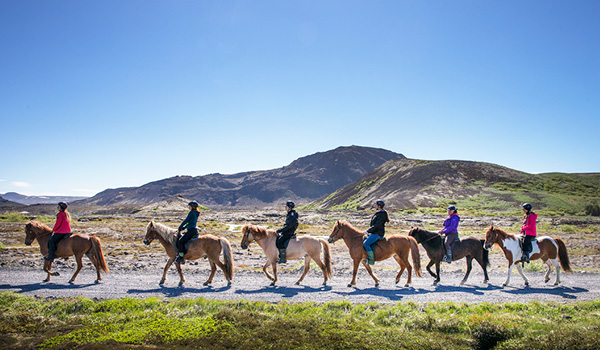
Being the hardy creatures they are, you can spot Icelandic horses grazing in paddocks throughout the year, even in the harshest of winter weather. In summer they are free to roam and graze far and wide, so you’ll probably spot more Icelandic horses out and about in the warmer, sunnier months.
September is a special time for the Icelandic horse as the annual Réttir events take place. As the season turns from the balmy days of summer to the crisp chill of winter, horses and sheep are rounded up from their wild summer in the mountains to return to the paddocks and fields around their home farms. Horses that have summered in the paddocks are used to round up the sheep and their fellow equines, and if you visit Iceland in September, you might spot farmers performing Réttir yourself.
But the biggest celebration of the Icelandic horse takes place on the 1st May every year. The Icelandic horse community, from all corners of the world, will gather together to show off and celebrate their hardy little steeds and stables open up across the land.
• For more information about when to visit Iceland for all kinds of activities, check out our blog post about the best time to visit Iceland.
Best places to see horses in Iceland
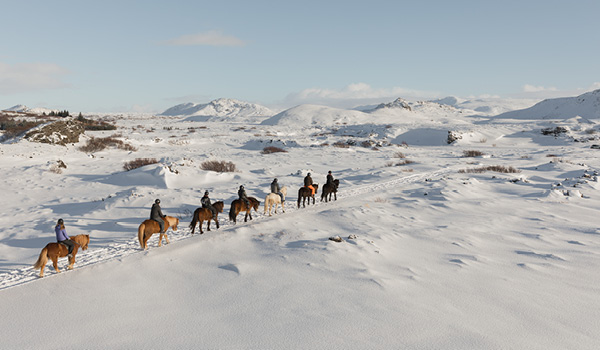
All across the island, farms and small holdings use horses to assist with the daily labour and you can spot these beautiful creatures grazing and running free in the mountains during the summer months. For a guaranteed sighting of an Icelandic horse, head to the Sólvangur Icelandic Horse Center, just fifteen minutes outside of Reykjavik and along the route of the Golden Circle. This place offers stable visits, riding lessons and a café stop too.
Also, driving along the south coast, it’s not uncommon to spot horses running along the long stretches of black-sanded beaches as the waves crash dramatically in the background. This is a fine photo opportunity, for sure.
Horse riding tours in Iceland
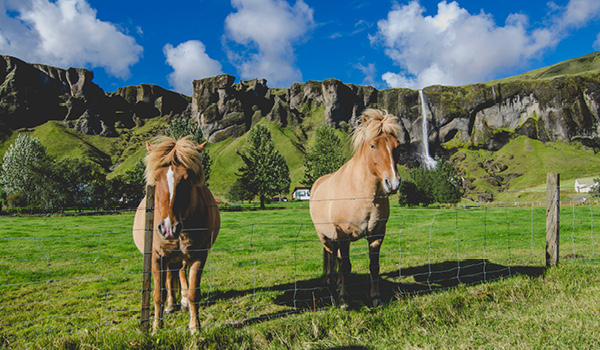
Reykjavik Excursions have a few tours that incorporate horse riding into the itinerary. Booking a guided tour can be the best way to get to know these beautiful creatures as a local guide can help you understand the unique temperament of the Icelandic horse. Equipment is provided and the guides know the best bridle paths and routes to witness the wild Icelandic scenery from horseback.
Locals believe that you shouldn’t ride a horse in Iceland if you don't know or understand their name. So before you start one of our horse riding tours, ask your guide about the name of your new equine friend and make sure you understand its meaning too.
• Take in the beautiful scenery of the lava fields on horseback on the adventurous lava tour.
• Combine the classic sights of the Golden Circle with a spot of riding on this tour that takes in waterfalls, geysers and an experience riding Icelandic horses.
What to wear for horse riding tours in Iceland?
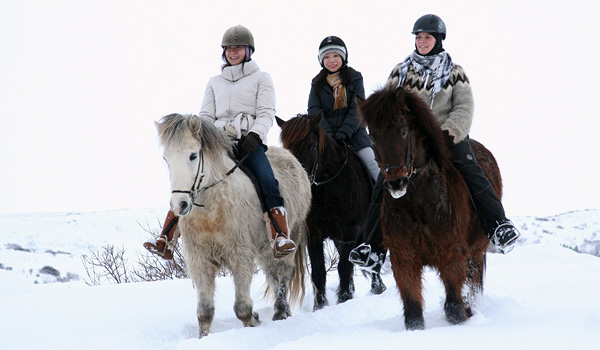
Due to its changeable weather and dramatic climate, it can be hard to know what to wear on a trip to Iceland. But we can help you out if you’re planning to go horse riding while you’re here.
The horses are hardy, so horse riding tours operate in all kinds of weather; rain, sunshine and even snow. It’s all about layers when dressing for any outdoor activities in Iceland, and horse riding is no exception. With a t-shirt, jumper (perhaps a woollen number to fit in with the locals) and waterproof jacket, you’ll be as hardy as an Icelandic horse on your ride. If it’s raining, waterproof trousers are a good idea, especially as Icelandic horses are known for being excellent at traversing through the glacial rivers that weave across the landscape.
Tours usually included a helmet for safety (you might want to bring a woolly hat in the colder months) and provide riding boots. You’ll definitely want a pair of gloves to protect your hands from the chilly wind as you hold the reins.
So, that’s it. The Icelandic horse has come to be loved and even revered over the centuries. Reykjavik Excursions offer a few tours and activities in Iceland where you can get up close and personal with these unique creatures. Now that you know everything there is to know about the friendly, stubborn, hardy little fellow there’s nothing left to do but visit and meet one for yourself. Just remember to get your horse’s name before you take it for a ride.
Blogg
Fáðu innblástur! Upplýsingar og góð ráð, áhugaverðir áfangastaðir, skemmtilegar staðreyndar og margt fleira. Bloggið okkar er á ensku en það er stórskemmtilegt engu að síður!
The Silver Circle of West Iceland - Your Guide
You’ve heard of the Golden Circle, but here’s why you should head to Iceland’s western region to explore the msytical Silver Circle tour route.
Lesa bloggThe Icelandic Horse: your guide
Find out what makes Icelandic Horses unique, why they can’t return to Iceland and how to ride these beautiful creatures yourself with our guide.
28. september 2022
The Icelandic Horse: your guide
Find out what makes Icelandic Horses unique, why they can’t return to Iceland and how to ride these beautiful creatures yourself with our guide.
28. september 2022
Known to horse breeders and equine enthusiasts across the world for its hardy nature, friendly demeanour and unique traits, the Icelandic horse stands out from all other breeds. A history of pure breeding, being forbidden to return once it leaves Iceland’s shores and resistance to any other horse breeds on the island means the Icelandic horse is unlike any other. The horse is loved and revered across Iceland, woven into the culture, mythology and literature, and you can get to know this intriguing equine breed yourself with our selection of horse riding tours and activities in Iceland.
The history of the Icelandic Horse
The first Norse settlers brought horses to Iceland, as far back as the 9th century when written records tell of the era of settlement. The Icelandic horse has survived the dramatic changing of the restless land over the centuries, from volcanic eruptions to bitter cold, harsh winters and mini ice ages.
Around 900 years ago, attempts to introduce eastern stock into the bloodline, saw significant degeneration, almost wipinging out the species. So the Icelandic horse has remained purebred, with no external genetics permitted to enter the bloodline.
Throughout history, horses have been essential to the survival of the Icelandic people. Horses were a reliable form of transportation across the island, able to carry heavy loads, and they even saved lives. Riders lost in the harsh blizzards of Icelandic winter would be kept warm by their horses, or their steed would trot on home with the exhausted or injured rider on their back.
The road network across Iceland in modern times has certainly reduced the need for a horse. But the Icelandic horse still holds a place in the country’s heart – still used for herding sheep in the mountains, leisurely rides on the beach and in racing and competitions.
Characteristics of the Icelandic Horse
Throughout the centuries, only the best horses were chosen for breeding in Iceland. Breeding horses were chosen based on specific characteristics, such as colour and equine conformation. Icelandic horses can often be seen sporting a fabulous, thick mane and come in around forty different colours and various patterns.
Those that come face-to-face with an Icelandic horse might see its stocky build and shorter-than-average legs and assume it would be classed as a pony. They usually stand between 13 and 14 hands high.
Adapting to its habitat over the centuries, the Icelandic horse grows a thick coat in winter and sheds to a lighter coat in summer. Due to the care and attention given by owners to their Icelandic horses, the average lifespan is up to 40 years. The oldest reported Icelandic horse lived until 59 years old.
Icelandic Horses in Mythology and folklore
 "Odin Rides to Hel" (1908) by W. G. Collingwood.
"Odin Rides to Hel" (1908) by W. G. Collingwood.
Horses were so intrinsic to Icelandic society that they appear in the country’s first book of laws. In it, the theft of horses was declared as punishable by banishment from the community, making horse thieves outlaws. Back in the Viking Age, if you were an outlaw, you could legally be killed on sight.
During the Viking Age, when the dead were buried with their personal belongings, kings and chieftains would often be buried with their trusty steed. Horses were considered valuable and there was a belief that they could assist your way to the land beyond.
One of the most famous horses in Norse mythology is Odin’s eight-legged steed, Sleipnir. In Iceland, the Northern canyon of Ásbyrgi is said to have been made by the imprint of Sleipnir’s hoof as he planted a foot there mid-flight.
Not all mythical horses were as friendly as their real counterparts. One of the monsters of Icelandic folklore, the Nykur, was a horse-like water demon whose ears and hooves faced backwards. The Nykur would hang out near lakes and rivers, pretending to be a normal horse and lure unsuspecting victims to a cold, watery grave. The cracking and groaning of ice on water is said to be the neighing of the Nykur. You can hear this sound yourself at Jökulsárlón glacier lagoon, but from the safety of a boat.
Interesting facts about the Icelandic Horse

Casting your eyes across the rugged Icelandic mountains, you may assume you’re spotting wild horses grazing in the greenery and running free across the landscape. However, the vast majority of horses in Iceland belong to farms or stables. There is just a tiny herd of actual wild Icelandic horses, estimated to be around 100 in the whole country.
In Iceland, each horse is treated as important as a human, in terms of registration that is. Horses are given their own ‘kennitala’ (like a social security or national insurance number). Most owners keep track of their horses via an app on their phones.
Icelandic horses come in over 100 different colours and patterns. The rarest of these is considered to be litföróttur – roughly translating as ‘colour travellers’. In these horses, the coat colour changes several times a season, creating a sort-of in-between colour look.
You can sometimes spot Icelandic horses with piercing blue eyes, the colour of ice shards. Sometimes a white colouring over the eyes can cause this effect.
• For more interesting facts about Iceland in general, check out our blog post on the best fun facts about the island.
The Five Gaits of the Icelandic Horse and the unique Tölt

Like all horses, the Icelandic horse can perform the three traditional gaits – a walk, trot and gallop. But there are two unique traits to the Icelandic horse that set it apart from the rest of the equine world. The tölt is a fluid, smooth movement without the bumpy bounce you usually experience during horse riding. During the tölt, at least one of the horse’s hooves is on the ground at any one time.
The skeið is fast – it can be up to 48km/h (or 30mph). Both legs on one side of the horse touch the ground at the same time, making this gait look a little like a human running. It’s often called ‘flying speed’ as there are points during this gait where the horse’s hooves don’t touch the ground at all.
It is said to be the Icelandic horse’s unique genetic mutations that allow it to perform these two unique gaits.
Frequently asked questions about the Icelandic Horse

o How many horses are there in Iceland?
It’s easy to keep track of how many horses there are in Iceland as each one is registered with a unique number. Currently, it is estimated that there are around 80,000 horses in Iceland. That’s a lot for a country of just 350,000 people. Overall, there are around 180,000 Icelandic horses across the world, and of the 100,000 that live outside of Iceland, the biggest number is in Germany where this sturdy little breed is very popular.
o Why can't Icelandic horses return?
Yes, it’s true; once they leave the country, Icelandic horses are not allowed to return. The ancient Althing parliament passed laws in 982 AD preventing the importation of any other horse breeds to the island. So, for over a thousand years, the Icelandic breed has been kept in complete isolation. Iceland is also completely free from hoof and mouth diseases, so cannot risk re-importing a horse once it has left Icelandic soil.
o Are Icelandic horses friendly?
Icelandic horses are one of the friendliest breeds in the world. Apart from being small but mighty, and their two unique gaits, what makes the Iceland horse so special is its friendly temperament. With vast, open greenery to run around in as foals, the Icelandic horses have happy childhoods filled with freedom and little contact with anything other than other horses. So, because they have never encountered any natural predators, they are approachable and friendly as they are not easily spooked.
o Why is an Icelandic horse not a pony?
Although there’s no official definition of a pony, generally an equine standing less than 14.2 hands is considered a pony, rather than a horse. The Icelandic horses stand between 13 and 14 hands, so they should be classed as ponies by all logic. However, it is said that the Icelandic breed’s ability to carry heavy weights, their spirited temperament and their general hardiness means that they are considered horses by Icelanders and non-Icelanders alike. After all, they can do everything a horse does and have the demeanour of a horse.
The most likely reason they are considered horses is simply; tradition. Icelanders have always called them horses, and so it has come to be. You can’t argue with that!
Best time to see horses in Iceland

Being the hardy creatures they are, you can spot Icelandic horses grazing in paddocks throughout the year, even in the harshest of winter weather. In summer they are free to roam and graze far and wide, so you’ll probably spot more Icelandic horses out and about in the warmer, sunnier months.
September is a special time for the Icelandic horse as the annual Réttir events take place. As the season turns from the balmy days of summer to the crisp chill of winter, horses and sheep are rounded up from their wild summer in the mountains to return to the paddocks and fields around their home farms. Horses that have summered in the paddocks are used to round up the sheep and their fellow equines, and if you visit Iceland in September, you might spot farmers performing Réttir yourself.
But the biggest celebration of the Icelandic horse takes place on the 1st May every year. The Icelandic horse community, from all corners of the world, will gather together to show off and celebrate their hardy little steeds and stables open up across the land.
• For more information about when to visit Iceland for all kinds of activities, check out our blog post about the best time to visit Iceland.
Best places to see horses in Iceland

All across the island, farms and small holdings use horses to assist with the daily labour and you can spot these beautiful creatures grazing and running free in the mountains during the summer months. For a guaranteed sighting of an Icelandic horse, head to the Sólvangur Icelandic Horse Center, just fifteen minutes outside of Reykjavik and along the route of the Golden Circle. This place offers stable visits, riding lessons and a café stop too.
Also, driving along the south coast, it’s not uncommon to spot horses running along the long stretches of black-sanded beaches as the waves crash dramatically in the background. This is a fine photo opportunity, for sure.
Horse riding tours in Iceland

Reykjavik Excursions have a few tours that incorporate horse riding into the itinerary. Booking a guided tour can be the best way to get to know these beautiful creatures as a local guide can help you understand the unique temperament of the Icelandic horse. Equipment is provided and the guides know the best bridle paths and routes to witness the wild Icelandic scenery from horseback.
Locals believe that you shouldn’t ride a horse in Iceland if you don't know or understand their name. So before you start one of our horse riding tours, ask your guide about the name of your new equine friend and make sure you understand its meaning too.
• Take in the beautiful scenery of the lava fields on horseback on the adventurous lava tour.
• Combine the classic sights of the Golden Circle with a spot of riding on this tour that takes in waterfalls, geysers and an experience riding Icelandic horses.
What to wear for horse riding tours in Iceland?

Due to its changeable weather and dramatic climate, it can be hard to know what to wear on a trip to Iceland. But we can help you out if you’re planning to go horse riding while you’re here.
The horses are hardy, so horse riding tours operate in all kinds of weather; rain, sunshine and even snow. It’s all about layers when dressing for any outdoor activities in Iceland, and horse riding is no exception. With a t-shirt, jumper (perhaps a woollen number to fit in with the locals) and waterproof jacket, you’ll be as hardy as an Icelandic horse on your ride. If it’s raining, waterproof trousers are a good idea, especially as Icelandic horses are known for being excellent at traversing through the glacial rivers that weave across the landscape.
Tours usually included a helmet for safety (you might want to bring a woolly hat in the colder months) and provide riding boots. You’ll definitely want a pair of gloves to protect your hands from the chilly wind as you hold the reins.
So, that’s it. The Icelandic horse has come to be loved and even revered over the centuries. Reykjavik Excursions offer a few tours and activities in Iceland where you can get up close and personal with these unique creatures. Now that you know everything there is to know about the friendly, stubborn, hardy little fellow there’s nothing left to do but visit and meet one for yourself. Just remember to get your horse’s name before you take it for a ride.
Blogg
Fáðu innblástur! Upplýsingar og góð ráð, áhugaverðir áfangastaðir, skemmtilegar staðreyndar og margt fleira. Bloggið okkar er á ensku en það er stórskemmtilegt engu að síður!
The Silver Circle of West Iceland - Your Guide
You’ve heard of the Golden Circle, but here’s why you should head to Iceland’s western region to explore the msytical Silver Circle tour route.
Lesa blogg